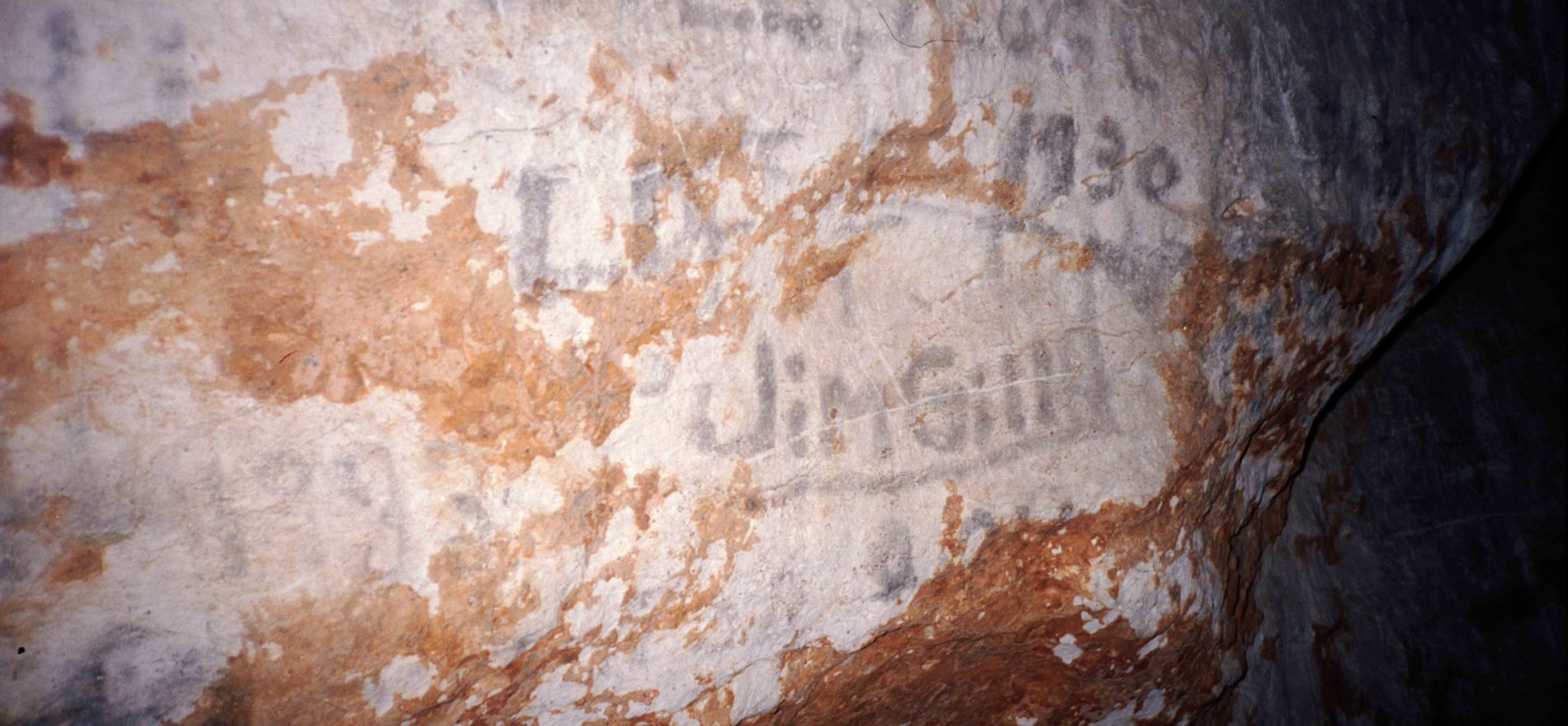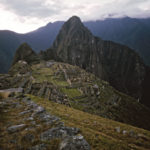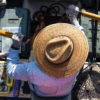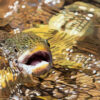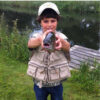Jim Gilley was his name. He was not more than 20 years old at the time and was already making his mark on the world: quite literally in fact. He had just finished signing his name using smoke as his pen on the rock-ribbed cavern wall deep beneath the hills near Big Stone Gap, Virginia. Stepping back, he held the flickering light against the sooty black letters printed on the limestone. He looked at it admiringly, pleased with his careful penmanship.
Though the light was dim, he saw that the enclosed chamber was no longer secluded in the darkness, hidden in the depths of the earth far from human contact. His freshly smoked letters were simple in their own right, quite unassuming, and yet dwarfed among hundreds of names snaking, twisting and encircling him in a silent archive of adventurers who had come before him. There were signatures everywhere that spilled over the hollow arches, crevices and rocky outcroppings. Was there an untouched space free of inscription? Who knew?
Flickering flames danced across the rock, casting eerie shadows and glimpses of names that had long remained unseen in a void of darkness. This place seemed ancient and yet ageless at the same time. If one could lean closer to the wall you would probably hear the walls sigh, “So… you’ve come too, have you? Leave your mark. So many others have. I don’t mind one more.”
“And so, I did just that,” he said matter of factly with a slight nod. We were seated on his comfortable sofa in his apartment in Lynchburg, Virginia. Glancing up, I could see him nodding silently with eyes that looked beyond us—at something only he could see. An instant shadow of melancholy pervaded the room, but he seemed deeply satisfied. Was he revisiting a vision of his youth? Perhaps so. A faint boyish grin was beginning to crinkle the corners of his mouth, and the gleam in his eyes sparkled, reflecting an inner vigor cherished and now lost. It was a stark contrast taking in the slight figure of a man of 91 years. Old age had eclipsed his roaming youth and replaced it with mature wisdom.
“You should go up sometime and see if it’s still there,” he said, chuckling to himself.
About a year later we accepted his offer. The plan was to locate the cave, find Jim Gilley’s signature and explore a bit while we were there. It appealed to my inner tomboy self who was always eager to delve into unknown territory.
“Surely it must be here somewhere,” I panted. Beads of sweat were now dripping into my eyes, stinging them as I scanned the mountain searching for signs of anything resembling a cave-like rock formation. It was only May, but already it was beginning to feel like summer. My dad and older brothers were steadily climbing uphill in a two steps forward, one step back kind of fashion. The dense underbrush and leaves created a thick carpet on which we slid, scurried and swayed as we ascended the rugged terrain. Our flailing hands grasped at random roots, rocks and tree limbs as we took hold and hoisted ourselves slowly and steadily up. Always up.
Finally, an elated voice broke the silence. “I found it! This must be it!” shouted my brother. Sure enough after summoning just enough reserve strength to scramble closer to his voice, I could see that he was not mistaken. An arched outcrop rose before us. The molded rock gaped like a mouth, receding into darkness, curving slightly and obscuring the interior from further view. I had imagined something grander in scale and a bit less foreboding. I at least wanted enough assurance to confirm that some other natural visitor was not lying undisturbed somewhere deep within. But this being an adventure and coming so far, it was out of the question to turn back now.
The low opening was just three feet high, and only one person at a time could walk, or rather stoop, inside the entrance. In single file, we hunched forward and crept along, rounding the curved passageway that ushered us into a portal, like a subterranean black hole. Our headlamps were now the sole source of illumination, replacing the rays of golden sunlight that slipped away from us as we ventured further and further in. The comforting sounds of wind and birds were soon quickly swallowed up and replaced with the methodical drip, drip, drip of water droplets plinking onto the rocks below. Every sound was amplified. Even our muffled footsteps now took on a heaviness that increased in loudness with each stride. The sacred quiet stillness that had permeated the atmosphere only moments ago was now broken by our shuffling strides.
At first, we had a relatively uneventful descent with no unexpected surprises. I had just begun to develop a sense of confidence and ease as I navigated my way through the serpentine crevices of the underground cavern. And more than likely it was at this point when my newly acquired confidence was in danger of slowly exceeding my healthy sense of caution.
We had begun to round a corner when I noticed a sliver of light casting a feeble glow on a tall and narrow rockface. The rock appeared normal enough, but it had a curious wave-like motion to it as if it was undulating in an unseen ocean.
“Why is the wall moving?” I whispered. My voice sounded unusually loud in the stillness.
“It’s not,” my brother replied, giving me a skeptical glance. “Your eyes do funny things in the dark, you know.”
I shrugged. Maybe he was right. Nerves mixed with imagination can give rise to some unearthly illusions, but all the same, I peered at the wall a second time… and this time, I could not be mistaken.
“The wall is moving. Don’t you see it?”
My dad focused his light on the wall, and pinpricks of light reflected back at us. They were eyes! Not the eyes of some wild predator lurking in the shadows, but tiny eyes that seemed to multiply the longer we looked at them. Spindly legs scampered across the smooth surface in a frantic attempt to escape the blinding light illuminating their dark abode. Spiders!
The wall was covered in them, a ghastly blanket of thousands of arachnids. It was this sight that replicated a wave swaying back and forth in a uniform, rhythmic motion. Streams of water trickled down the wall leaving dark stained lines of moisture that resembled an enormous web stretching upwards out of sight. They were cave spiders, quite harmless, but that minor detail completely escaped our minds as we subconsciously sidestepped backwards.
It was quite some time before we eased ourselves past the spiders. Our backs scraped against the adjacent wall, and we cast wary glances as the wall continued to oscillate. Abruptly, we came to a halt at what appeared to be the end of our path which was obstructed by a large boulder suspended between the walls. But careful inspection revealed a narrow gap underneath that allowed us to squeeze through. Emerging onto the other side, the faint ghostly silhouette of a ladder leaned casually against the wall. It had been abandoned here during the days of mining saltpeter for gunpowder in the 1860s. Despite its age, it proved to be sturdy enough and well-preserved. This ladder was unique in design in that it was a single post with roughly cut notches as footholds and no side rails. Clutching the post and hoisting ourselves upward, we came across a log that jutted across a shallow pit like a diving board hovering over an empty pool. This is where our luck seemed to be tested. We edged over the gap and were nearly safely across when a loud clatter shattered the silence. Peering cautiously below, we surveyed our loss.
A flashlight lay at the bottom, still casting its beacon against the rock. It had slipped the bonds of a carelessly knotted rope ferrying it across the chasm. We wondered how and more importantly who would retrieve it.
“I think I can reach it if you just tie me in,” said my brother. “It doesn’t look far, a few yards maybe.”
“Are you sure? Your eyes do funny things in the dark, you know,” I said. He glanced doubtfully at me; with a rope properly secured around his waist, he slipped silently out of sight into the mouth of the pit. The rope creaked as it adjusted to its heavy burden. Anxious thoughts raced through our minds. What if the rope wouldn’t hold? We’d lose much more than a flashlight.
Sweat poured from our brows and ragged gasps escaped our lungs as we tugged at the rope, hoisting it up and up until my brother emerged gripping the flashlight.
“Your knot tying skills have remarkably improved,” he said with a faint grin.
“It has to when the burden on the other end is more valuable,” I replied.
It was quite some time until our spatial awareness altered, and we began to sense a shift, both in space and height. We entered into the presence of a large round hall with a gallery soaring upwards. It might as well have been a concert hall with the distant haunting echoes reverberating randomly in the emptiness—echoes that had the unearthly resemblance of dissonant chords played by an unseen symphony. Gazing upwards, the light radiating from our headlamps dissolved with increasing height. Only a few feet from us, an underground stream disappeared noiselessly through the center of the floor. This was quite overwhelming. Branches of side chambers weaved in and out from the main hall, and we spun in wonder with the seemingly endless outlets that led to unknown destinations.
Soon came the question we had all been pondering, but had been afraid to voice for fear that our suspicion would come true: “Which one of the many tunnels is our exit?”
A simple question no doubt, but was the answer obvious? No, not really. In fact, let’s be honest, any of these tunnels could be “the one.” How was it possible to say this path was right when all the paths looked exactly the same?
Finally, we went with our gut feeling, but quickly found that it only led us to a dead end. And quite literally a dead end for no sooner had we turned around to retrace our steps we were met with a grim image of a skull and crossbones inscribed in bold, black smoke. The words “This way out” curled beneath the bones as if luring us in to meet a most unfortunate fate.
Maybe it was a mixture of curiosity, disbelief or panic that prompted us to take this risk. Most likely it was all three of these, but this was the path that we took. The passage was only about two feet tall; it forced us to drop to our knees and crawl on our bellies. We slithered through this narrow channel with the soot-stained ceiling hovering over our heads. Evidently, other people had come here too with carbide lanterns. But where did they end up? Did they find the exit?
The tunnel’s walls gradually broadened enough for us to straighten upright, and soon a side chamber perpendicular to the main path emerged from the shadows. We entered cautiously as our lights canvassed the room. I felt a sense of awe and wonder; it was as if one had stepped inside an autograph room. Jim Gilley’s description of this place was brought to life as names, initials and dates from over two centuries created a vibrant textured tapestry. Printed and cursive—rough and neat, narrow and wide—the names blended and swam into each other until it was difficult to decipher where one began and another ended. Locating his name would be quite a challenge.
As if mentally flipping through a phone book, I scanned the last names beginning with G. I slowed my gaze down more carefully and came across names like “Galvin, Goodman, Giles and so forth, but where was Gilley?
“Gosh, I must be getting close,” I thought, perplexed. And then, there it was right in front of me in striking clarity. Neatly inscribed on the wall in tall, proud letters was the name “Jim Gilley.”
He had stood here more than 70 years ago and yet his name was unblemished by erosion or sunlight. We took a photograph, eager to share our discovery with Mr. Gilley and satisfy his sentimental desire to see his signature once more.
Viewing his autograph connected the youth of Mr. Gilley to my own in a tangible way. This elderly man introduced to me as the son of my great-great grandmother’s sister became a more kindred spirit after our adventure in the cave.
“You should go up sometime and see if my name’s still there,” he had said.
I smiled. “It’s still here, Mr. Gilley. And it will be here for quite a long time.”
Cover photo: Jim Gilley was his name. More than 70 years later, the author found it inscribed on a rock-ribbed cavern wall near Big Stone Gap, Virginia. Photo by Emily Powers

